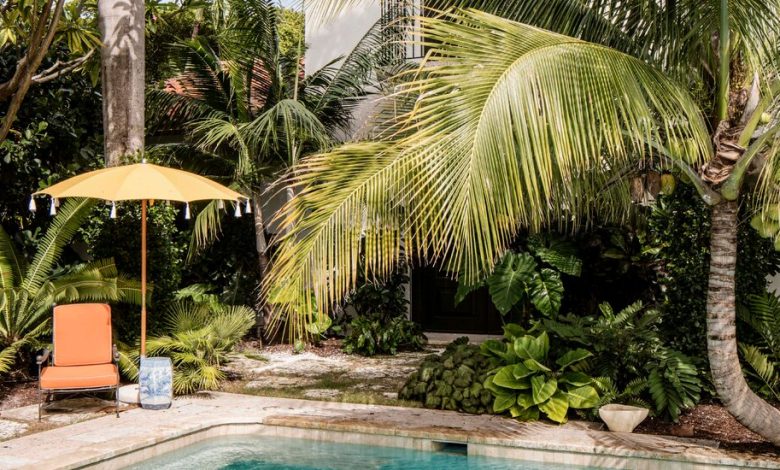A House Where Old Miami Style Meets Old World Bohemianism

IT CAN BE hard to tell in Miami what’s natural and what isn’t. The sky is often uncannily blue, the vegetation (palms, sea grapes, jacarandas) a startling green. The bright white sand on South Beach is Floridian but trucked in from mines to combat coastal erosion. And the spiny iguanas that look so at home among the tropical shrubs are in fact invasive, descendants of pets imported from South America in the 1960s; sometimes in the winter, they fall frozen from trees, landing on car windshields. Indeed, Miami often seems engaged in a battle against its own wild, swampy environs — a conflict that plays out with growing urgency in the city’s architecture. As temperatures and sea levels rise, the glass-fronted towers along the coast seem increasingly ill suited to their surroundings.
But on a muggy morning last May, a building of another sort, far rarer now in the city, was pleasantly dark and cool inside. Set on a residential street in Miami Beach’s Bayshore neighborhood, whose properties back onto an inlet of Biscayne Bay, it belongs to an earlier surge of construction in the 1940s, when the preferred dwellings of wealthy Miamians were low-slung, hacienda-like homes with thick walls and terra-cotta tile roofs — the kind that for centuries have kept houses cool in Spain and Latin America. This particular two-story, four-bedroom house, following the traditional style, is shaded and discreet. Dense beds of philodendrons and banana trees line the red brick driveway, pushing up against the white plastered facade, from which only a few small windows face outward. The 7,000-square-foot home’s focal point is, instead, inside: a large rectangular courtyard bursting with palms and giant elephant ear plants and bordered by a colonnade shaggy with wisteria. If the building’s more modern neighbors — glass cubes with manicured lawns — seem somehow both sealed against the elements and vulnerable to them, this house feels solid and purpose-built. On warm days, the doors are left open and the rooms fill with the salty sea breeze.
THE HOME’S OWNERS, a couple who work in hospitality, bought the property more than two decades ago, choosing it precisely because it contrasted with the glossy starkness of Miami’s contemporary architecture. When they decided to redecorate in 2018, they wanted a collaborator who would accentuate its history while also keeping comfort in mind. (The family often hosts at the house, enjoying long meals in the courtyard that typically end with fruit from a stand of mango, guava and papaya trees.) They’d met the Italian-born architect Fabrizio Casiraghi, 37, a few years before and knew he would do just that. Since founding his Paris-based practice in 2015, Casiraghi has become known for creating eclectic, romantic spaces that feel luxurious but lived in, both aristocratic and bohemian. He changed little of the home’s exterior but reimagined its rooms, filling them with the kinds of vintage furniture and curios typically amassed over lifetimes. “They wanted an architect who wouldn’t do something minimal,” says Casiraghi, “because it’s not a minimalist space.”




